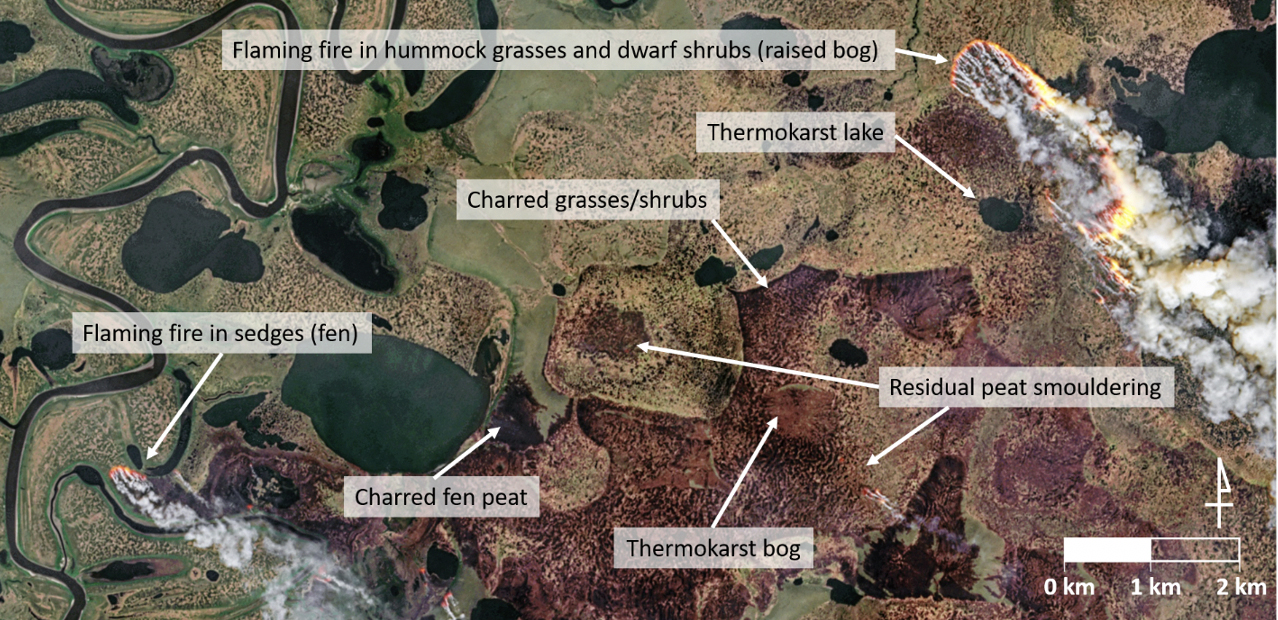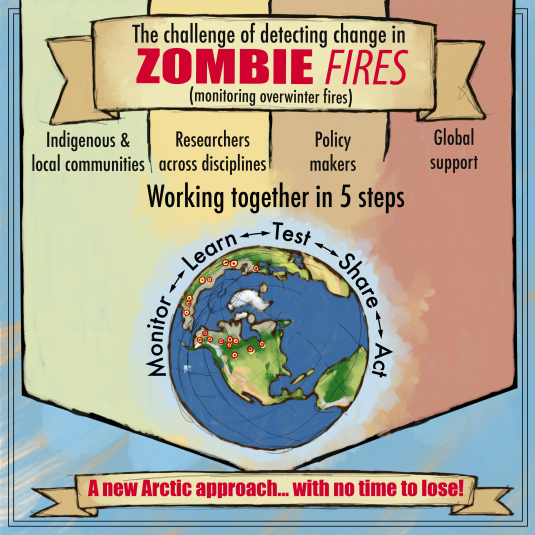

Miami fire scientist: "Zombie fires" one of new features driving Arctic fires
New approaches needed to wildland fire fighting to save the Arctic: “There’s no time to lose”
By Shelley Sommer, Institute of Arctic and Alpine Research (INSTAAR), University of Colorado, Boulder, and Susan Meikle, Miami University news and communications

Illustration courtesy INSTAAR
“Zombie fires” and burning of fire-resistant vegetation are new features driving Arctic fires—with strong consequences for the global climate—warn international fire scientists in a commentary published last week in Nature Geoscience.
Fire scientist Jessica McCarty, assistant professor of geography at Miami University, and her team found that “Arctic fires are burning earlier and farther north, in landscapes previously thought to be fire resistant.”
The team has been tracking fire activity in the Russian Arctic in real time using a variety of satellite and remote sensing tools.
While wildfires on permafrost in Siberia south of the Arctic are not uncommon, the team found that 2019 and 2020 stood out as extreme in the satellite record for burning that occurred well above the Arctic Circle, a region not normally known to support large wildfires.
Co-author Merritt Turetsky, a fire and permafrost ecologist at INSTAAR, said that it’s not just the amount of burned area that is alarming. “There are other trends we noticed in the satellite data that tell us how the Arctic fire regime is changing and what this spells for our climate future.”
Thomas Smith, third co-author and a fire scientist at the London School of Economics and Political Science, said that nearly all of this year's fires inside the Arctic Circle have occurred on continuous permafrost, with over half of these burning on ancient carbon-rich peat soils. “The record high temperatures and associated fires have the potential to turn this important carbon sink into a carbon source, driving further global heating,” he said.
There is no time to lose in fighting to save the Arctic, McCarty said. “We need global cooperation, investment and action in monitoring fires, including learning from Indigenous and local communities how fire is traditionally used.”
Read more in the INSTAAR news story "The Arctic is burning in a whole new way."

Jessica McCarty
McCarty is assistant professor of geography and director of Miami's Geospatial Analysis Center. Her research focuses on using geospatial and remote sensing science and technology to monitor and predict wildland and human-caused fire, greenhouse gas emissions and impacts on air quality, in addition to applications in food security, land-cover/land-use change and climate change. Her work is supported by funding from NASA, the National Science Foundation, the USDA and the United Nations, among other organizations.
She is a U.S. representative to the Arctic Council’s Arctic Monitoring and Assessment Programme’s Expert Group on Black Carbon and Methane, the United Nations Environmental Programme’s Climate and Clean Air Coalition, the Intergovernmental Panel on Climate Change’s Working Group on Biomass Burning, and the International Union of Forest Research Organizations special working group, FIRE$: Economic Drivers of Global Wildland Fire Activity.
- Follow her on Twitter: @jmccarty_geo
In other words: Poetry inspired by zombie fires
McCarty and her team were surprised to hear from science communicator Sam Illingworth (poet, chief executive editor for Geoscience Communications and programme leader for science communication at the University of Western Australia), who shared his poem inspired by their research.
"Zombie Fires"
Buried beneath the snow line,
these smouldering corpses
begin to glow.
Forgotten fires, whose reanimated embers
burn brightly across the tundra;
frozen bodies recoiling
at the heat
of their undying embrace.
Read the entire poem posted Oct. 2 on The Poetry of Science blog.
